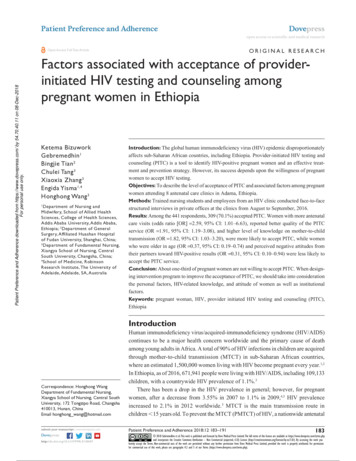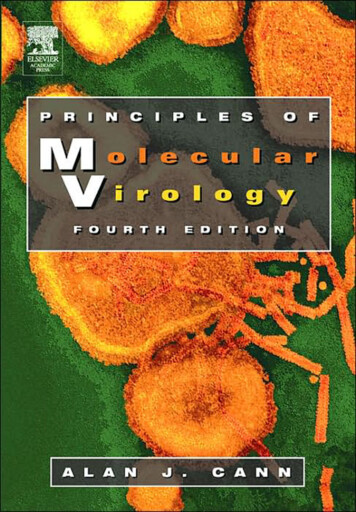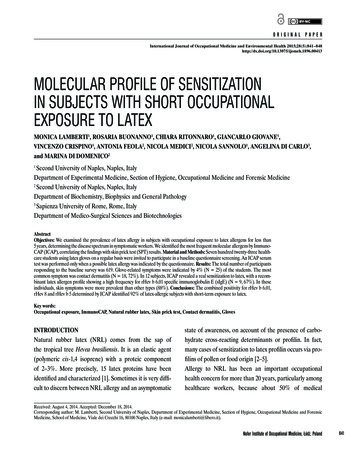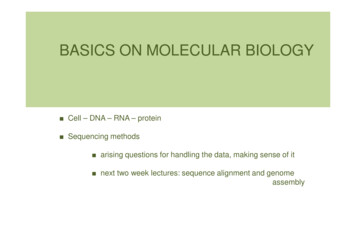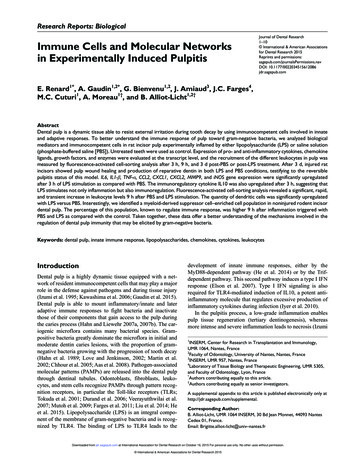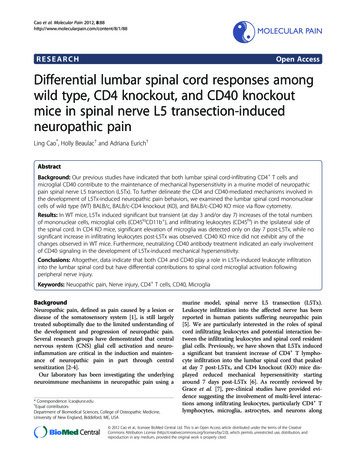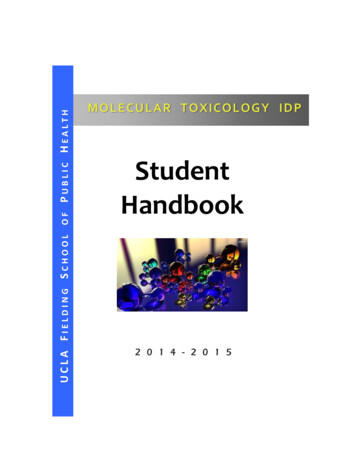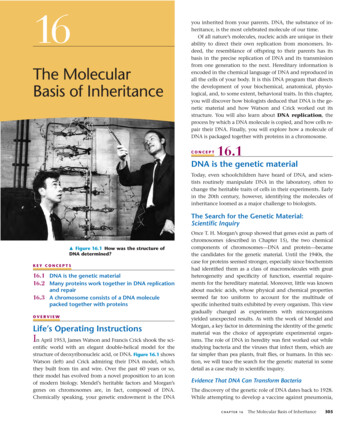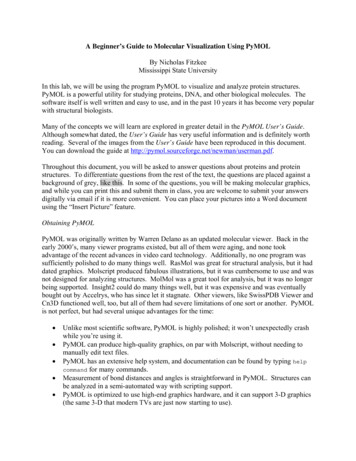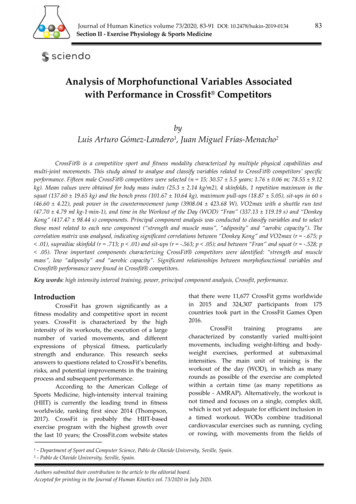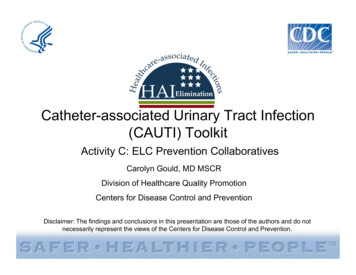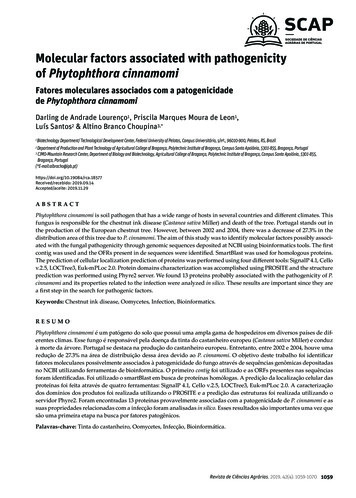
Transcription
Molecular factors associated with pathogenicityof Phytophthora cinnamomiFatores moleculares associados com a patogenicidadede Phytophthora cinnamomiDarling de Andrade Lourenço1, Priscila Marques Moura de Leon1,Luís Santos2 & Altino Branco Choupina3,*Biotechnology Department/ Technological Development Center, Federal University of Pelotas, Campus Universitário, s/nº., 96010-900, Pelotas, RS, BrazilDepartment of Production and Plant Technology of Agricultural College of Bragança, Polytechnic Institute of Bragança, Campus Santa Apolónia, 5301-855, Bragança, Portugal3 CIMO-Mountain Research Center, Department of Biology and Biotechnology, Agricultural College of Bragança, Polytechnic Institute of Bragança, Campus Santa Apolónia, 5301-855,Bragança, Portugal(*E-mail:albracho@ipb.pt)12 o: 2019.09.14Accepted/aceite: 2019.11.29ABSTRACTPhytophthora cinnamomi is soil pathogen that has a wide range of hosts in several countries and different climates. Thisfungus is responsible for the chestnut ink disease (Castanea sativa Miller) and death of the tree. Portugal stands out inthe production of the European chestnut tree. However, between 2002 and 2004, there was a decrease of 27.3% in thedistribution area of this tree due to P. cinnamomi. The aim of this study was to identify molecular factors possibly associated with the fungal pathogenicity through genomic sequences deposited at NCBI using bioinformatics tools. The firstcontig was used and the OFRs present in de sequences were identified. SmartBlast was used for homologous proteins.The prediction of cellular localization prediction of proteins was performed using four different tools: SignalP 4.1, Cellov.2.5, LOCTree3, Euk-mPLoc 2.0. Protein domains characterization was accomplished using PROSITE and the structureprediction was performed using Phyre2 server. We found 13 proteins probably associated with the pathogenicity of P.cinnamomi and its properties related to the infection were analyzed in silico. These results are important since they area first step in the search for pathogenic factors.Keywords: Chestnut ink disease, Oomycetes, Infection, Bioinformatics.RESUMOPhytophthora cinnamomi é um patógeno do solo que possui uma ampla gama de hospedeiros em diversos países de diferentes climas. Esse fungo é responsável pela doença da tinta do castanheiro europeu (Castanea sativa Miller) e conduzà morte da árvore. Portugal se destaca na produção do castanheiro europeu. Entretanto, entre 2002 e 2004, houve umaredução de 27.3% na área de distribuição dessa área devido ao P. cinnamomi. O objetivo deste trabalho foi identificarfatores moleculares possivelmente associados à patogenicidade do fungo através de sequências genômicas depositadasno NCBI utilizando ferramentas de bioinformática. O primeiro contig foi utilizado e as ORFs presentes nas sequênciasforam identificadas. Foi utilizado o smartBlast em busca de proteínas homólogas. A predição da localização celular dasproteínas foi feita através de quatro ferramentas: SignalP 4.1, Cello v.2.5, LOCTree3, Euk-mPLoc 2.0. A caracterizaçãodos domínios dos produtos foi realizada utilizando o PROSITE e a predição das estruturas foi realizada utilizando oservidor Phyre2. Foram encontradas 13 proteínas provavelmente associadas com a patogenicidade de P. cinnamomi e assuas propriedades relacionadas com a infecção foram analisadas in silico. Esses resultados são importantes uma vez quesão uma primeira etapa na busca por fatores patogênicos.Palavras-chave: Tinta do castanheiro, Oomycetes, Infecção, Bioinformática.Revista de Ciências Agrárias, 2019, 42(4): 1059-1070 1059
INTRODUCTIONThe Oomycete fungus Phytophthora cinnamomi isa soil pathogen extremely aggressive and it has awide range of hosts, that includes almost 500 plantsspecies in more than 70 countries (Jung et al., 2013).It was described firstly in Sumatra (Indonesia) byRands (1922) as being the causative agent of cinnamon (Cinnamomum burmannii) stripe cancer.Due to its potential pathogenicity, P. cinnamomigenerates substantial economic losses in agriculture, afforestation, and horticulture. This pathogenis associated with the oak decline in Mediterranean Europe and with the oak disease in California(Brasier et al., 1993; Robin et al., 1998; Vettraino etal., 2002; Garbelotto and Hüberli, 2006). Further, itcauses root rot in fynbos in South Africa, leadingto its death (von Broembsen & Kruger, 1985; Nagelet al., 2013). In addition, its introduction in natureleads to severe consequences to the natural ecosystem and biodiversity (Hardham and Blackman,2018).The Oomycetes class, which includes genus Phytophthora, belongs to Pseudofungi phylum withinthe Chromista kingdom. The characteristics thatdefine the Chromista are the asexual reproduction of mobile spores endowed with a flagellumadorned by tubular hairs, which are responsiblefor motility. These spores start the plant infectionin many species of Phytophthora, including P. cinnamomi (Beakes et al., 2012; Hardham and Blackman, 2018). P. cinnamomi also is responsible forthe European chestnut ink disease (Castanea sativa Miller) and, worsening this problem, C. sativais very susceptible to infections by this pathogen(de Sampaio e Paiva Camilo-Alves et al., 2013). Thesymptoms of this disease include yellowing andpremature fall off the leaves and the appearance ofwet rot in the roots, which will lead to the death ofthe tree (Fernandes, 1953; Shattock, 2001).The European chestnut tree has economic interestsdue to the fruit and wood production, as well asother Castanea species. Portugal is the third-largestEuropean chestnut tree producer, with 27.337 tonsin 35.426 hectares (INE, 2016) and the Cold LandChestnut Production Zone is responsible for theproduction of 80% of the national chestnut (INIAV, 2016). However, the C. sativa production has1060 Revista de Ciências Agrárias, 2019, 42(4): 1059-1070been declining over the years due to the epidemic proportions of P. cinnamomi, only between 2002and 2004, the area of distribution decreased 27.3 %(Martins et al., 2007; Pereira, 2017).Despite several species are affected by P. cinnamomi,European chestnut trees receive special highlightsin Portugal due to the economic importance for thecountry (INIAV, 2016). Additionally, P. cinnamomiis ranked as one of the most aggressive species ofPhytophthora genus to the C. sativa (Vettraino etal., 2001). However, the ink disease still the mainthreat once P. cinnamomi is resistant to the available fungicides and there are no effective optionsof pest control (Santos et al., 2016). Still, the molecular mechanisms involved in the pathogenicity ofP. cinnamomi remains unclear.The plant infection by P. cinnamomi is initiated bybinding the zoospores to the plant root elongationregion (Hardham, 2005). This binding is providedby some proteins, like adhesine Vsv1 (Hardhamand Gubler, 1990; Robold and Hardham, 2005).Then, zoospores enter the stage of encystmentwith the formation of biofilm from secreted proteins. Between 20-30 minutes after the zoosporesencystment, the cyst germinates and the hyphaeare formed (Hua et al., 2013; Hardham and Blackman, 2018). These hyphae are responsible for theproduction of some enzymes that will degrade theplant cell wall, such as the ones that belong to theCell Wall-Degrading Enzymes (CWDEs) family(Götesson et al., 2002; Ospina-Giraldo et al., 2010;Larroque et al., 2012; Blackman et al., 2014). Theintracellular and intercellular growth of hyphaein the radicular cortex towards the cortical andvascular tissues leads to water stress and necrosis(Hosseini, 2010; Hardham and Blackman, 2018).Bioinformatic provide promising tools for analysisin silico and to support in vivo assays. In the context of this work, ORFFinder and smartBLAST aretwo tools from NCBI that enable an easy and trustworthy search for open read frames in genomic sequences and provides determination of homologyof these sequences (Rawat et al., 2018). Concerningthe protein structures, the SignalP 4.1 is a reliabletool for the prediction of the signal peptide (Petersen et al., 2011; Ayalew et al., 2017). Considering thatsecreted proteins are highly important to the pathogenicity of pathogens, the prediction of subcellular
localization is indispensable. Among the availableonline bioinformatics tools LocTree3 (Nair andRost, 2005; Sanasam and Kumar, 2019), Cello (Yuet al., 2004; Thakare et al., 2016) and Euk-mPLoc(Chou, 2019) stand out. In line with this, the identification of domains and motifs of proteins are veryuseful to determine the proteins functions. PROSITE is an online tool for searching for significantsites in amino acid sequences (Gellért et al., 2006;Sigrist et al., 2009). Finally, determine the proteinstructure through modeling is essential to analyzeits conformation. For this use, PHYRE2 is a veryused web-based tool for modeling amino acid sequences (Zhang et al., 2011; Singh and Gupta, 2016).Considering the economic losses caused by P. cinnamomi in European chestnut trees it is extremelyimportant that molecular factors responsible forthe pathogenicity of this pathogen are identified.Thus, the aim of this study was to identify genesand its products related to the pathogenicity ofP. cinnamomi, as well as the characterization of theresults obtained through bioinformatics tools.MATERIAL AND METHODSDatabase of biological informationFor the search of genes, the genomic sequencesfrom Phytophthora cinnamomi used are depositedin the National Center for Biotechnology Information (NCBI) (https://www.ncbi.nlm.nih.gov/).To continue the research from the group usedthe sequence (REF: LGSK01000001.1) deposited byStudholme et al. (2016) which belongs to the strainMP94-48 (BioSample: SAMN03921829; BioProject:PRJNA290836; Assembly: GCA 001314365.1).Alignment Search Tool (Blast), specifically thesmartBlast version, also available by NCBI. Thistool establishes the homology between the sequences deposited in several protein databasesavailable.Prediction of cellular localization of proteinsThe software SignalP 4.1 (http://www.cbs.dtu.dk/services/SignalP/) was used to analyze the presence of signal-peptide. The following softwareswere used to predict the sub-cellular location ofproteins: Cello v.2.5 (http://cello.life.nctu.edu.tw/); LOCTree3 (https://rostlab.org/services/loctree3/);and Euk-mPLoc 2.0 . Each one analyzes proteins indifferent ways and for all tools, the selected parameters were: “Eukaryotes” for organism or domainand “Protein” for the type of sequence.Gene and proteins characterizationGenes and their products were characterizedthrough bioinformatics tools that allow the identification of domains, patterns, and motifs, as well asactive center and physical-chemical characteristics.Therefore, we used the PROSITE (https://prosite.expasy.org/) tool, in “Quick Scan” mode, excludingmotifs with a high probability of occurrence.The structural prediction of the proteins foundwas performed using the Phyre2 (http://www.sbg.bio.ic.ac.uk/ phyre2/html/page.cgi?id index )server, using the normal modeling mode. For visualization and representation of the structures, weused the Jmol program.Open Read Frames (ORFs) search and homologyRESULTS AND DISCUSSIONIn order to find de ORFs present in genomic sequences we used the ORFFinder tool (https://www.ncbi.nlm.nih.gov/orffinder/), available by NCBI,with the following parameters: minimal ORFlength: 300 nucleotides; genetic code: Standard;ORF start codon to use: “ATG” only.1980 ORFs, larger than 300 nucleotides, establishedby the ORFfinder program, were analyzed usingthe smartBlast in search of homology. Of theseORF’s, we found 13 ORFs that encoded for proteinshomologous related to the pathogenicity in different organisms mostly of the genus Phytophthora, asshown in Table 1. The selection method was basedon a link between the protein sequence and thepathogenicity in other organisms. This link wasThe homology of proteins encoded by the ORFsfounded was determined using the Basic LocalLourenço et al., Pathogenicity factors of Phytophthora cinnamomi 1061
Table 1 - Selected genes possibly related to the pathogenicity of P. cinnamomi and their products according to the data foundin the studyGeneAccessionProteinPHALS 03704NCBI: 36398759AM587 10014656EMBL: KUG02203.1Engulfment and cell A0A0P1AZ20motility elm familyproteinNephrocystin-3A0A0W8E0S2PHPALM 11761EMBL: POM71642.1PHMEG 000772PHMEG 000217EMBL: OWZ24236.1 CarbohydrateesteraseNCBI: 9467416Phosphatidylinositolkinase (PIK-G1)EMBL: OWZ21687.1 TransmembraneproteinEMBL: KUF93685.1 E3 ubiquitin-proteinligase HERC4EMBL: KUF76294.1 E3 ubiquitin-proteinligase HERC2NCBI: 9467389Glycosidehydrolase, putativeEMBL: OWZ24694.1 Serine proteaseA0A225X3M6PHMEG 000637EMBL: OWZ24320.1 Cysteine proteaseA0A225X505NCBI: 20662776G4YMD2PITG 03453PHMEG 0003727AM587 10007505AM587 10008051PITG 03425PHYSODRAFT 551981PITG 03400NCBI: 9464554Cysteine proteasefamily C26Papain-like cysteineprotease C1Crinkler (CRN)family protein,putativeestablished with references in the scientific literature available. The data about the genes chosenand their related products are presented in Table 1.All information about these genes and their products including scientific references can be obtainedfrom the databases referred to in Table 1 throughthe accession number of each gene in the respective database.The prediction of cellular localization of proteinsinforms their destination after leaving the endoplasmic reticulum. This destination often dependson the signaling of a signal peptide. The results ofthe prediction of cellular localization of the proteins encoded by the ORFs selected are in Table 2.To obtain these results we used: SignalP to determine the presence or absence of signal peptide inthe protein; Cello, LocTree3, and Euk-mPloc, whichfrom different algorithms, predict the cellular localization of proteins.1062 Revista de Ciências Agrárias, 2019, 42(4):
of pest control (Santos et al., 2016). Still, the molec-ular mechanisms involved in the pathogenicity of P. cinnamomi remains unclear. The plant infection by P. cinnamomi is initiated by binding the zoospores to the plant root elongation region (Hardham, 2005). This binding is provided by some proteins, like adhesine Vsv1 (Hardham and Gubler, 1990; Robold and Hardham, 2005). Then, zoospores .
